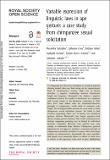Files in this item
Variable expression of linguistic laws in ape gesture : a case study from chimpanzee sexual solicitation
Item metadata
| dc.contributor.author | Safryghin, Alexandra | |
| dc.contributor.author | Cross, Catharine Penelope | |
| dc.contributor.author | Fallon, Brittany Laurie Ann | |
| dc.contributor.author | Heesen, Raphaela | |
| dc.contributor.author | Ferrer-i-Cancho, Ramon | |
| dc.contributor.author | Hobaiter, Cat | |
| dc.date.accessioned | 2022-11-10T10:30:13Z | |
| dc.date.available | 2022-11-10T10:30:13Z | |
| dc.date.issued | 2022-11-09 | |
| dc.identifier | 281805134 | |
| dc.identifier | fa86919e-67f5-4636-84d4-ee78609583c5 | |
| dc.identifier | 85143136264 | |
| dc.identifier | 000882385700003 | |
| dc.identifier.citation | Safryghin , A , Cross , C P , Fallon , B L A , Heesen , R , Ferrer-i-Cancho , R & Hobaiter , C 2022 , ' Variable expression of linguistic laws in ape gesture : a case study from chimpanzee sexual solicitation ' , Royal Society Open Science , vol. 9 , no. 11 , 220849 . https://doi.org/10.1098/rsos.220849 | en |
| dc.identifier.issn | 2054-5703 | |
| dc.identifier.other | ORCID: /0000-0002-3893-0524/work/122719783 | |
| dc.identifier.other | ORCID: /0000-0001-8110-8408/work/122720114 | |
| dc.identifier.uri | https://hdl.handle.net/10023/26354 | |
| dc.description | Funding: European Commission - European Union’s 8th Framework Programme, Horizon 2020. | en |
| dc.description.abstract | Two language laws have been identified as consistent patterns shaping animal behaviour, both acting on the organizational level of communicative systems. Zipf's law of brevity describes a negative relationship between behavioural length and frequency. Menzerath's law defines a negative correlation between the number of behaviours in a sequence and average length of the behaviour composing it. Both laws have been linked with the information-theoretic principle of compression, which tends to minimize code length. We investigated their presence in a case study of male chimpanzee sexual solicitation gesture. We failed to find evidence supporting Zipf's law of brevity, but solicitation gestures followed Menzerath's law: longer sequences had shorter average gesture duration. Our results extend previous findings suggesting gesturing may be limited by individual energetic constraints. However, such patterns may only emerge in sufficiently large datasets. Chimpanzee gestural repertoires do not appear to manifest a consistent principle of compression previously described in many other close-range systems of communication. Importantly, the same signallers and signals were previously shown to adhere to these laws in subsets of the repertoire when used in play; highlighting that, in addition to selection on the signal repertoire, ape gestural expression appears shaped by factors in the immediate socio-ecological context. | |
| dc.format.extent | 13 | |
| dc.format.extent | 835745 | |
| dc.language.iso | eng | |
| dc.relation.ispartof | Royal Society Open Science | en |
| dc.subject | Compression | en |
| dc.subject | Communication | en |
| dc.subject | Zipf | en |
| dc.subject | Menzerath | en |
| dc.subject | Language | en |
| dc.subject | QL Zoology | en |
| dc.subject | RC0321 Neuroscience. Biological psychiatry. Neuropsychiatry | en |
| dc.subject | BF Psychology | en |
| dc.subject | DAS | en |
| dc.subject | MCC | en |
| dc.subject.lcc | QL | en |
| dc.subject.lcc | RC0321 | en |
| dc.subject.lcc | BF | en |
| dc.title | Variable expression of linguistic laws in ape gesture : a case study from chimpanzee sexual solicitation | en |
| dc.type | Journal article | en |
| dc.contributor.sponsor | European Research Council | en |
| dc.contributor.institution | University of St Andrews. Centre for Social Learning & Cognitive Evolution | en |
| dc.contributor.institution | University of St Andrews. School of Psychology and Neuroscience | en |
| dc.contributor.institution | University of St Andrews. Centre for Research into Equality, Diversity & Inclusion | en |
| dc.contributor.institution | University of St Andrews. Institute of Behavioural and Neural Sciences | en |
| dc.identifier.doi | 10.1098/rsos.220849 | |
| dc.description.status | Peer reviewed | en |
| dc.identifier.grantnumber | 802719 | en |
This item appears in the following Collection(s)
Items in the St Andrews Research Repository are protected by copyright, with all rights reserved, unless otherwise indicated.

